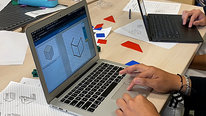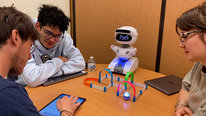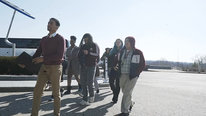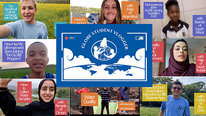- Alexandria Ardissone
- https://www.linkedin.com/in/alexandria-ardissone-a3a65497/
- Assistant Scientist
- Presenter’s NSFRESOURCECENTERS
- University of Florida
- Jennifer Drew
- http://www.linkedin.com/in/jennifer-drew-5780ba169
- Senior Lecturer
- Presenter’s NSFRESOURCECENTERS
- University of Florida
- Eric Triplett
- Professor and Chair
- Presenter’s NSFRESOURCECENTERS
- University of Florida
Choice
Florida Pathways to Success: A Research University/Minority-Serving Community...
NSF Awards: 1643780
2022 (see original presentation & discussion)
Undergraduate, Adult learners
Transfer students represent a diverse and talented student population that is often overlooked by large research universities. The 2+2, or vertical, transfer pathway is the most common transfer pathway, yet less than 20% of bachelor’s degree-seeking students that start at 2-year institutions will transfer to and graduate from 4-year institutions within 6 years. The majority of the nation’s student are community college students, and for various reasons find community college a more accessible entry point to higher education.
In an effort to broaden participation and increase access to a STEM bachelor’s degree, the Florida Pathways to Success program is a partnership between the Microbiology and Cell Science (MCS) department at the University of Florida (UF) and Miami Dade College (MDC), a Hispanic-serving institution, to provide scholarships and research experiences to high-achieving, low-income students in the 2+2 transfer pathway, either pre- (students enrolled at MDC) or post-transfer (students enrolled at UF). In addition to a traditional, on-campus degree program, the MCS department at UF offers an online bachelor’s program for 2+2 transfer students, intended to minimize the barriers to transfer that accompany relocation. However, there continues to be a knowledge gap in understanding the barriers transfer students face in transferring to and graduating from four-year institutions. Knowledge gained through the Florida Pathways to Success program will reduce this knowledge gap and reiterate the need for innovative approaches to promote the retention and success of transfer students.
Related Content for Florida Transfer Student Pathways to Success in Microbiology
-
 2022The Extremophiles
2022The Extremophiles
Brooke Coley
-
 2022Software to Increase Success, Diversity, & Retention in STEM
2022Software to Increase Success, Diversity, & Retention in STEM
Lelli Van Den Einde
-
 2022Female STEM Recruitment Overview
2022Female STEM Recruitment Overview
Kevin Cooper
-
 2022Designing Innovative AI to Support K-12 Collaboration
2022Designing Innovative AI to Support K-12 Collaboration
Rachel Dickler
-
 2022GAMECHANGER: 30 Years of Diversifying the STEM Pipeline
2022GAMECHANGER: 30 Years of Diversifying the STEM Pipeline
Deb Cole
-
 2022Redesigning Gateway Mathematics at a Two-Year HSI
2022Redesigning Gateway Mathematics at a Two-Year HSI
Mary Pilgrim
-
 2022A pathway to technology literacy through art creation
2022A pathway to technology literacy through art creation
Raffaella Borasi
-
 2022Meet The GLOBE Program's GLOBE Student Vloggers
2022Meet The GLOBE Program's GLOBE Student Vloggers
Jan Heiderer



Donna Stokes
This is a great program for supporting transfer student who often times are not the focus of scholarship programs.
Alexandria Ardissone
Alexandria Ardissone
Assistant Scientist
Hi Donna! Thank you for your comment. Yes, focusing on transfer students has been incredibly insightful.
Scott Horrell
I think supporting transfer students is critical and I work to do so at our institution as well. I'm interested in learning more about how the scholarship works for pre-transfer students - is it awarded before they begin or after they complete a year? Is it linked to a future research experience? I am also interested in how students are recruited. Thanks and great program!
Alexandria Ardissone
Alexandria Ardissone
Assistant Scientist
Hi Scott, thank you for your questions! I will do my best to answer questions regarding pre-transfer students. Our Miami Dade College collaborators and sub-awardees on this project could provide more detail if needed, and I’d be happy to put you in contact with them.
Awards for pre-transfer students are merit-based, requiring a minimum GPA of 2.5, so recipients have completed at least one term. They must also have at least 2 terms remaining to graduate. Recruitment occurs through print and digital flyers as well as student email listservs.
The application process for MDC pre-transfer students includes an application form and a brief (no more than 2 pages, 12pt double-spaced) essay describing career goals and transition to a four-year institution, so intent to transfer is established. Students are specifically asked where they’d like to transfer to and why. MDC awards 50 students per year who have declared a major in STEM (Health Science majors are not eligible).
As for future research experience, about 20% of scholarship recipients (pre- and post-transfer at MDC and UF, respectively) in any given year receive summer research stipends through the Florida Pathways S-STEM program (excluding summer 2020). However, we know that several students are gaining research experiences through other resources via term surveys that we give to our S-STEM students. We understand the value and impact of research experiences and experiential learning in general, which was a major motivation for including in this project.
We are beginning to take a closer look at the data we have collected from students who have completed summer research through this program (we have collected tracking data and our program evaluator has conducted surveys and focus groups with each summer cohort). We are very interested to see the impact of research experience on student success and scientific identity. Also, in receiving the financial support of an academic scholarship to pursue STEM education, do students feel more enabled and/or eager to pursue scientific research? I think the two, scholarship AND research opportunities, are complementary and so very much contribute to a student’s success in STEM.
Sarah Haavind
Scott Horrell
Scott Horrell
Thank you for your response, Alexandria. I very much look forward to seeing what your group learns about how this program empowers its participants.
Jeff Milbourne
STEM Coordinator-Writing and Learning Center
Great program concept with some encouraging outcomes. I'd echo Donna's comment about transfer students as a program focus. Also, the hybrid model is a really good way of increasing accessibility and broadening participation. Have you noticed any differences in the experiences of full-time vs. part-time/hybrid participations in the program?
I'm curious to learn more about the research experience piece: what kinds of outcomes does this program component create for students? Does participation in this experience have a role to play in the higher graduation rates? What are students learning from those experiences (or what do you think they might learn)? I'm a big fan of research experiences for students, so I think it's great that you're incorporating these activities into your program!
Alexandria Ardissone
Sarah Haavind
Sarah Haavind
Senior Research Project Manager
Hello Alexandria, Jennifer and Eric! Wonderful program, excellent video presentation and, as Jeff notes above - encouraging outcomes already! Kudos. Jeff asks a lot of great questions here, as does Bhaskar below. I look forward to learning more from your responses when you have time and then to dig deeper. Thanks in advance!
Alexandria Ardissone
Assistant Scientist
Great questions thank you, Jeff! The online-hybrid track has greatly increased the accessibility of our microbiology major. Without this track, we would not have the diversity of ‘nontraditional’ students in our program to study some of these issues. In fact, it was because the award rate to our online-hybrid students was so low that we were alerted to full-time enrollment being a significant barrier to these students in receiving the scholarship.
You can read more details about the publication referenced in the video here: https://doi.org/10.1007/s10755-021-09549-7
We observed that part-time/hybrid students graduated in a similar amount of time and similar (trending slightly better) overall GPAs than their on-campus transfer student peers. Through thematic analysis of student text responses, full-time enrollment is just not possible for some students. Many of these students work full or nearly full-time, have dependents and just have very different life situations compared to the ‘traditional’ 18-23 year old college student, so of course their educational experience would be quite different. Furthermore, the expectation of full-time enrollment can be a hindrance to students’ educational experience; a transfer student said, “I have to enroll full time for my scholarships to apply but it makes classes extremely difficult for me and I believe I would have a better educational experience if I were able to do part-time.” Overall, students are well aware of the benefits and disadvantages of enrolling full/part-time and that is a judgment call that institutional policies need to be more sensitive to. I think, in the past, part-time enrollment was often associated with lack of engagement/commitment to their education and hence decreased chance of success, but that just really isn’t the case with these students.
Sarah Haavind
Alexandria Ardissone
Assistant Scientist
As for research experiences, yes we see that It is very valuable for students. We know that at least 20% of students receiving this scholarship are also gaining research experience provided by this program, but a lot of our students are getting research experiences not directly funded by this program. We haven’t looked specifically at the effect of research experience on graduation rate/time. I imagine it would have a positive effect, but I am not sure that would be the best outcome. Most students are highly motivated to graduate and think the scholarship does a great deal in increasing the graduation rate/time. We hold a research symposium for our students at the end of the summer and ask students what they’ve learned personally in addition to scientifically, and as you can see in the clips in our video, students gain increased sense of self and confidence in pursuing science as a career. Therefore, I think the research experience does more to empower students to look beyond graduation and increase their scientific identity.
Bhaskar Upadhyay
Associate Professor
The transfer student focus is absolutely necessary if BIPOC students are to succeed in academia and professionally. The barriers to transfers between institutions need more focus and ways to overcome them. What would be one key feature of transfer success if this project's learning is to be emulated in other institutions? Great job.
Sarah Haavind
Eric Triplett
Professor and Chair
For us, one of the keys is to develop your program so that place bound students can still enroll in your program. We do NOT expect our students to be residential students as that may be financially or culturally difficult. Of course, the on-campus option remains for any transfer student. We have done this since 2011 by providing our lecture courses online.
John Kaup
Great S-STEM program. Really like to see the research opportunities provided both directly as well as through other avenues. We have found these research opportunities (especially early and often) are one of the best avenues for retention and can be particularly transformative for some students that struggle academically but shine in the laboratory setting.
Eric Triplett
Professor and Chair
John - so true. In my own case, I didn't like lab courses as an undergrad but loved my research experience in the lab as an undergrad because I had a purpose. I haven't left research since. Eric
Further posting is closed as the event has ended.